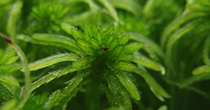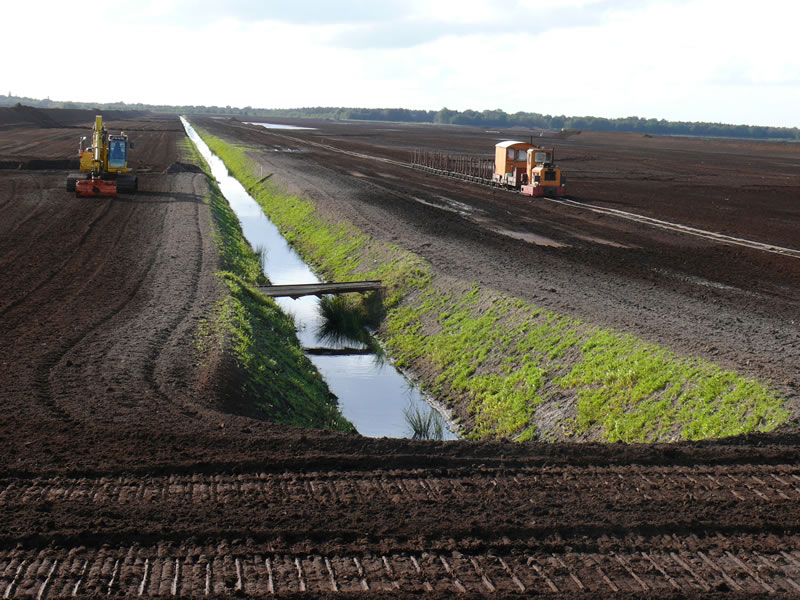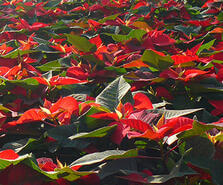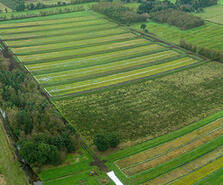Sphagnum Farming
Sphagnum farming on peat soils is a form of paludiculture on raised bog sites. Paludiculture („palus“ – Latin „swamp“) is agriculture and forestry on wet and rewetted peatlands.
What is Sphagnum Farming?

Sphagnum farming is the cultivation of peat moss (Sphagnum) for the production and harvest of peat moss biomass. The Sphagnum is cultivated in order to gain renewable raw material for the production of horticultural growing media as an alternative to using peat soil.
Potential sites for Sphagnum cultivation on peat soils are degraded former raised bog sites such as cut-over peat bogs or cultivated bogs, which are currently used as pastures and meadows. Alternatively, Sphagnum can also be cultivated on floating rafts on open water, former peat cuttings in degraded raised bogs or on lakes which developed after open-pit lignite mining.
The cultivation of Sphagnum has many benefits:
- Climate: Conservation of carbon fixed in peat and reduction of CO2 emissions by rewetting degraded peatlands
- Environment: Reduction of the emission of pollutants into ground and surface water in comparison to agricultural land use; renewed function of water purification and water retention in peatlands as well as a local cooling effect due to increased water evaporation.
- Wildlife: Habitats for rare and endangered Sphagnum species
- Landscape: Conservation of open landscapes.
- Economy: Renewable alternative to depleting fossil raw materials, creates jobs, provides an alternative means of income in rural areas, and creates value for the region.
Everyone consumes peat on a daily basis: either directly as potting soil or indirectly by consuming fruit and vegetables grown in peat. Peat is the most important and so far irreplaceable ingredient for the production of high quality growing media in horticulture. For this purpose, 3 million cubic metres of low humified peatmoss peat are used annually in Germany only. Worldwide consumption amounts to 30 million cubic metres, which will be emitted into the atmosphere as CO2 after short time usage.
Low humified moss peat is formed in functioning peatlands by the peat moss Sphagnum. These peat mosses grow at the tip and die off at the bottom. As a result of the waterlogged and acidic environment in bogs, part of the plant matter becomes preserved and accumulates as low humified moss peat. Through this process, a raised bog grows slowly upwards at a rate of about one millimetre per year.
In order to mine the moss peat for horticultural purposes, the fragile bog ecosystem is destroyed by drainage and the peat which took millennia to accumulate is mined in a matter of a few years. The carbon content which was stored within the peat is released as CO2 into the atmosphere after a relatively short period of time. When the peat strata is mined a whole archive of landscape and human history which is stored in the peat is destroyed.
As the resources of minable peat moss are almost exhausted in Western Europe, the German peat and compost industry increasingly imports moss peat from ever more distant regions. Since the fall of the Iron Curtain the peat comes mostly from the Baltic States in Eastern Europe. Germany currently is the largest producer and user of peat in commercial horticulture and imported 1.8 million cubic metres of peat in 2006.
The potential economic consequences of increasingly longer import distances and scarcity of peat moss could result in price increases of the growing media and an exodus of the horticultural industry out of Germany.
So far there has not been an alternative to peat moss that is equal in quality, a similar price, and available in large amounts.
Sphagnum biomass has the same properties as low humified peat moss and has been successfully tested in horticultural trials.
The cultivation of Sphagnum and the potential in the application of Sphagnum biomass have been investigated in four research projects at University of Greifswald.













